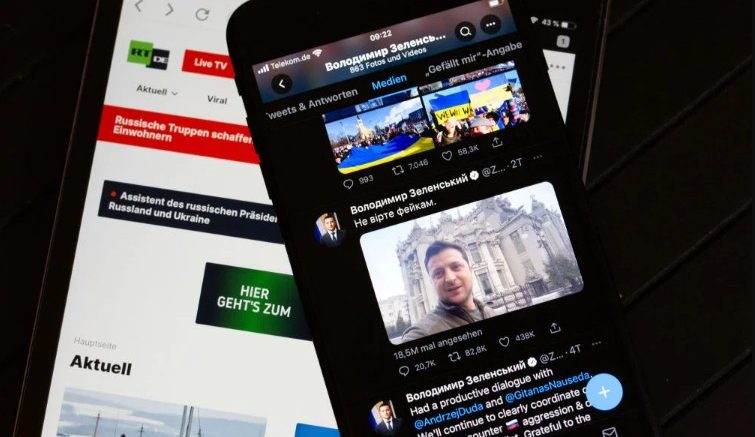Kristina Shalashenko, a therapist in Odessa, Ukraine, is living a nightmare every day, unsure whether or not Russia’s invasion will force her to escape her home. “It’s quite terrifying.” “Everyone is afraid and stunned,” she says, speaking via a translator. “The world [we’ve] known is no longer there.”
Kero Lubkova, who was born in Odessa and now lives in Colorado, spends her days checking news sites and social media for changes thousands of miles away. Lubkova does it because they “cannot focus on anything else,” not because the updates might affect their next decision.
People looking for updates across the world are seeing disturbing photographs and videos of buildings and bodies damaged by shelling in towns like Kyiv and Kharkiv, people and pets huddled in shelters, and Ukrainian citizens crying as they contact their loved ones to say farewell, just in case.
It’s a lot to take in. Lubkova says, “I really don’t think anyone should ever be acclimated to witnessing something like this.” “However, that’s essentially what it came down to.” If I want to know what’s going on in my nation, I’ll have to look at it with my own eyes.”
People in Ukraine and throughout the world are following the crisis on social media, in the form of unfiltered, personal TikTok videos, Instagram stories, and tweets, as well as traditional news sources. It isn’t the “first social media war,” as some have claimed; social media has been used to cover prior armed conflicts, such as the Syrian War, which began in 2011.
However, the way battles are covered on social media has changed dramatically over time. TikTok didn’t exist in 2011, and Instagram had just been around for a year. As of March 7, TikTok videos with the hashtag #ukrainewar had been viewed over 600 million times, and about 180,000 Instagram posts had utilized it.
This constant barrage of information has a significant effect: it encourages people to pay attention and provides a window into the lives of Ukrainians. However, keeping up with current events can be costly.
According to research, news coverage of horrific events can have an impact on viewers’ mental health—and with footage and photographs from Ukraine circulating on social media and disinformation abounding, this has public health consequences.
“People want to educate, inform, and bear witness,” says Jason Steinhauer, author of History, Disrupted: How Social Media and the Internet Have Transformed the Past. “The difficulty is that it’s embedded in this [social media] ecology and design, which is wrong at its core.”
According to Roxane Cohen Silver, a professor of psychological science at the University of California, Irvine who studies media coverage and trauma, the volume of media consumed and the graphic nature of the content have an impact on mental health.
In a study published in 2013, Cohen Silver’s team discovered that those who watched at least four hours of television coverage per day during the week following the September 11 attacks reported increased stress and symptoms of post-traumatic stress disorder (PTSD), as well as a higher risk of developing health problems years later.
It’s hard to compare the experience of living through a war to viewing it on television. However, Cohen Silver’s research suggests that even if people are not directly touched by a crisis, news coverage can have a significant impact on them.
Consuming at least six hours of related news coverage each day after the 2013 Boston Marathon bombing was connected to higher acute stress than being at the finish line when the explosives went off.
Cohen Silver says it’s tough to tell how social media versus traditional news coverage affects mental health because few people watch one or the other entirely.
However, there are a few key distinctions. Editors at traditional media sites decide which content is too graphic to show, and upsetting photos are frequently labeled with warnings. People, on the other hand, “may capture images and films and quickly broadcast them [on social media] without warning, possibly without thinking about it,” according to Cohen Silver.
The dissemination of misinformation is also a battlefield on social media. “Russia has been waging a social media and misinformation campaign for the past 10 to 12 years,” according to Steinhauer, and it has only become worse since its invasion of Ukraine. According to Reuters, Ukrainian officials have warned that Russia will likely circulate fake information implying that Ukraine has succumbed.
Instagram sites that purport to feature “on-the-ground” posts from Ukrainian journalists, but are actually operated by persons thousands of miles away, including a 21-year-old guy in the United States, were recently researched by the technology and culture website Input.
During a crisis, social media can be beneficial. It has been utilized by Ukrainian President Volodymyr Zelenskyy to communicate directly to residents and promote unity and strength among them.
As the crisis progresses, social media platforms have also aided Ukrainians in sharing their experiences with the world (particularly those in Russia who, due to misinformation, do not believe the war is taking place), contacting family members, and finding supplies and assistance.
However, according to Masha Mykhaylova, a licensed clinical social worker in San Francisco who was born in Ukraine, the spread of fake news and the constant possibility that online materials have been altered or stripped of crucial context can affect mental health by chipping away at our senses of reality.
“Being aware of the danger of coming across anything that is emotionally deceptive and misleading might have a psychological impact,” she explains. During the current COVID-19 pandemic, one recent example is the link between misinformation and poor mental health.
A new study published in JAMA Network Open looked at mental health during the pandemic and discovered a correlation between reporting depressive symptoms and believing vaccine disinformation (albeit the researchers couldn’t say if one caused the other).
The Ukrainian crisis comes after nearly two years of nonstop bad news and fake news about the virus, as well as innumerable stories about climate change, racism, injustice, and other emotionally charged topics. According to Cohen Silver, news coverage of the pandemic has led to mental discomfort, and adding another tough topic to the mix can exacerbate those feelings.
People who are anxious are more inclined to seek out crisis coverage, according to her research, potentially “fuel[ing] a cycle of distress…from which it’s very difficult to disentangle oneself.”
Turning off the screen and walking away can be beneficial for anxious people—and anyone, really. Cohen Silver says she has opted to read about the violence in Ukraine rather than watch photographs or films that could be psychologically detrimental, based on her studies.
Despite the difficulties, “abstaining from the news and social media doesn’t feel like an option” for people like Mykhaylova who have personal ties to Ukraine, she says. “When I’m engaged with what’s going on, especially if it’s information created by Ukrainians, I feel more peaceful and less disoriented.” It can be upsetting and upsetting…but my reaction feels like a justified one.”
Lubkova agrees, stating that, while seeing photographs and films from the war is painful, it’s much more difficult to accept that others don’t seem to care.
Nonetheless, Mykhaylova believes it is critical to set time limits for watching the news and checking social media. That limit will vary from person to person, and possibly even from day to day, but she believes that being informed should not come at the expense of sleep, food, or time outside. Getting treatment from a therapist can also be beneficial.
The need to constantly update social media is, in part, “a result of platforms and technologies that have been purposely intended to be addictive,” according to social media author Steinhauer.
Staying involved in the response to the crisis, he argues, is more vital than getting up-to-the-minute updates, whether that means sending money to groups that help Ukrainians, writing to representatives, or supporting people in your community who have ties to Ukraine.
Those positive behaviors “may be a substitute for the doom-scrolling that the devices and platforms drag us into, especially when there are these disastrous moments that demand all of us to stand up and pay attention,” according to the researchers.
That message is echoed by Shalashenko, an Odessa therapist. “I want the entire world to come together to help us get through this,” she says through a translator, “and to put an end to this horror.”





